Dispersants: a guided tour
| Topics: |
People responding to an oil spill may use several kinds of "countermeasures" intended to reduce the harm caused by the spill. Dispersants are one kind of countermeasure. Here's a basic explanation of what they are and how they work.
Contents
- 1 What are dispersants?
- 2 Why Use Dispersants?
- 3 How Do Dispersants Work?
- 4 How Are Dispersants Applied?
- 5 What Constraints Affect Dispersant Use?
- 6 What Happens to Dispersed Oil?
- 7 What Are Some Environmental Impacts from Dispersant Use?
- 8 A Toxicity Test Apparatus
- 9 How are Dispersant Applications Monitored?
- 10 Where are dispersants being used?
- 11 How is NOAA Involved?
- 12 What's the Bottom Line?
What are dispersants?
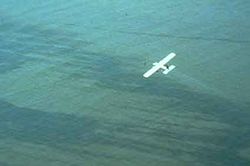 An airplane applying dispersant to an oil slick An airplane applying dispersant to an oil slick
|
Once oil has spilled, people use oil spill countermeasures to try to reduce the adverse effects of spilled oil on the environment. Dispersants are one kind of countermeasure. They are chemicals that are applied directly to the spilled oil in order to remove it from the water surface, where oil can be especially harmful. In the photo to the right, an airplane is applying dispersant to an oil slick.
When dispersants are applied to surface oil slicks, they act to break up the slicks and move the oil, in the form of tiny droplets, from the water surface down into the water column (the volume of water extending from the surface to the bottom).
The diagram below shows how dispersants work:
- First, the dispersant is applied to the water surface.
- Next, molecules of the dispersant attach to the oil, causing it to break into droplets.
- Wave action and turbulence then disperse the oil-dispersant mixture into the water column, so that
- the oil that had been concentrated at the surface is diluted within the water column{| width="200" border="1" cellspacing="1" cellpadding="1" align="center"
|  Diagram of four panels showing oil floating on surface of water in beaker, dispersant added to oil, energy added by shaking beaker, and oil dispesant mixture results
|}
Diagram of four panels showing oil floating on surface of water in beaker, dispersant added to oil, energy added by shaking beaker, and oil dispesant mixture results
|}
Why Use Dispersants?
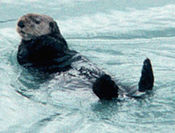 Sea otter resting on surface of water. Sea otter resting on surface of water.
|
Oil slicks on the water surface are particularly dangerous to seabirds and fur-bearing marine mammals. Oil interferes with the animal's or bird's ability to maintain its body temperature, often resulting in death from hypothermia.
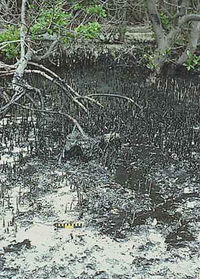 Oiled mangrove roots with scale Oiled mangrove roots with scale
|
Sea otters (Enhydra lutra), like the one at left, are especially vulnerable. Removing oil from the sea surface as quickly as possible reduces the risk to birds and mammals.
Dispersing an oil slick can also prevent oil from coming ashore, minimizing impacts to biologically sensitive shoreline environments, like the oiled mangrove swamp below, as well as economically-important areas like tourism beaches, and culturally-important areas, like archaeological sites.
Mangrove Swamps
Mangrove swamps (Mangrove ecology) provide valuable habitat for nesting birds, juvenile fish, and many other species. Mangroves are very vulnerable to oil, which can kill or cause lasting damage to the trees.
An Oiled Swimming Beach
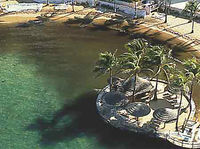 Oiled hotel beach and lagoon Oiled hotel beach and lagoon
|
Oil spilled from a damaged freighter came ashore in Puerto Rico in 1994, oiling this hotel swimming beach and lagoon (photo left). Floating oil, along with submerged oil mixed with sediment, appears as a dark patch along the lagoon shore.
How Do Dispersants Work?
Dispersants work much like the detergent soap that you use to clean grease from your dishes (but dispersants are less toxic). They contain molecules with a water-compatible ("hydrophilic") end and an oil-compatible ("lipophilic") end. These molecules attach to the oil, reducing the interfacial tension between oil and water, breaking up the oil slick, as shown below.
 Diagram showing dispersant being added to an oil slick, attaching to water and oil molecules, and seperating them. Diagram showing dispersant being added to an oil slick, attaching to water and oil molecules, and seperating them.
|
How Are Dispersants Applied?
Dispersants are usually applied by airplane or helicopter, but also can be applied by boat. To increase the chances that an application will be effective, spill responders try to choose the best combination of dispersant droplet size, concentration, and rate of application. They also try to carefully target dispersant applications, sometimes even using spotter planes that use infrared detectors to locate spilled oil as precisely as possible.
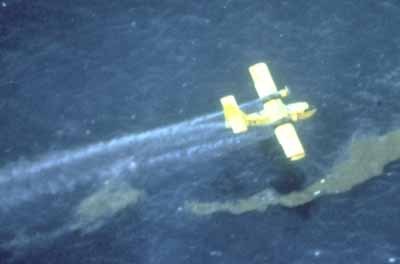 Here, an airplane applies dispersant to a streamer of oil. Here, an airplane applies dispersant to a streamer of oil.
|
What Constraints Affect Dispersant Use?
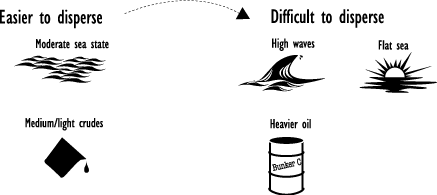 Diagram showing that medium and light crudes in a moderate sea state are easire to disperse than heavy oils in flat seas or with high waves. Diagram showing that medium and light crudes in a moderate sea state are easire to disperse than heavy oils in flat seas or with high waves.
|
The effectiveness of a given dispersant depends on the type of oil spilled (it is easier to disperse lighter oils), weather conditions, and how quickly dispersants can be applied once oil has spilled. Dispersants must mix with the oil and water, so some energy is required for effective dispersion. But too much wind and Wave energy may result in conditions that are dangerous for flying aircraft and that make it difficult to target the oil and properly apply the right amount of dispersant. Heavier oils or highly emulsified oils (oils that have mixed with water to form a heavy froth) are less amenable to successful dispersion, although research on new types of dispersants is attempting to address this problem.
The graphic above contrasts the kinds of conditions under which dispersants are likely to be more effective (shown on the left) with the kinds of conditions under which it's harder to disperse oil (shown on the right).
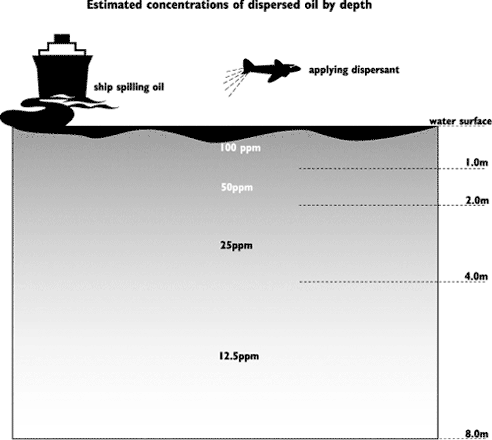 Diagram showing that medium and light crudes in a moderate sea state are easire to disperse than heavy oils in flat seas or with high waves. Diagram showing that medium and light crudes in a moderate sea state are easire to disperse than heavy oils in flat seas or with high waves.
|
What Happens to Dispersed Oil?
Initially, dispersed oil moves down into the water column to depths ranging from 1 to 10 meters (about 3 to 30 feet). To avoid contaminating the sea floor, most dispersant use to date has been restricted to waters deeper than 10 meters (about 30 feet). The diagram above shows concentrations of dispersed oil at different depths (estimated from field studies), during the first few hours after dispersants have been applied. These concentrations drop within hours as currents and waves disperse the oil further.
Eventually, dispersed oil droplets degrade (Natural oil degradation processes) into naturally occurring substances. There is evidence that dispersed oil degrades more quickly than oil that has not been dispersed. The diagram above illustrates how the oil may be processed in the marine ecosystem. First, the droplets of oil and dispersant are colonized by bacteria that then begin to degrade them. Next, protozoans and nematodes (small worms) join the colonies. Eventually, the oil may be further broken down and incorporated into the food web.
What Are Some Environmental Impacts from Dispersant Use?
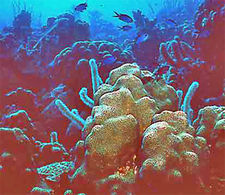 Coral reef Coral reef
|
Both dispersants and dispersed oil particles are toxic to some marine organisms. But because concentrations of dispersed oil are quickly diluted in the ocean, organisms are likely to be exposed only for short time periods. To try to understand how badly marine organisms might be harmed by dispersant application operations, researchers conduct experiments with specialized laboratory equipment.
In any particular situation, the decision to use dispersants involves balancing the potential advantages of dispersant use--removing oil from the water surface and avoiding some shoreline impacts--with the potential disadvantages, such as impacts to plankton or other water column organisms. Part of the work of planning the response to potential oil spills is the difficult task of evaluating these tradeoffs, which requires careful consideration of the resources and issues involved.
Because coral reefs (Oil spills in coral reefs) can be harmed by dispersed oil, dispersant use in the vicinity of coral reefs is usually restricted to areas where dispersed oil is unlikely to contact coral. These are areas far from the reefs, or located where currents would carry the dispersed oil away from the coral.
A Toxicity Test Apparatus
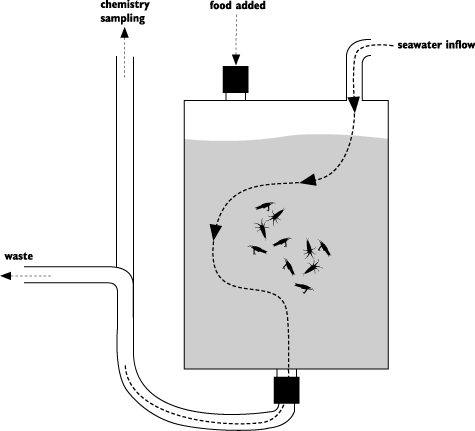 Diagram showing flow of seawater through tank containing organisms Diagram showing flow of seawater through tank containing organisms
|
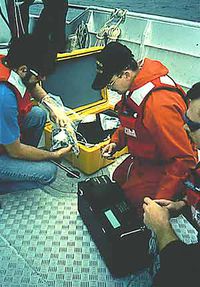 U.S. Coast Guard officers and a NOAA researcher preparing to deploy a fluorometer U.S. Coast Guard officers and a NOAA researcher preparing to deploy a fluorometer
|
The drawing above shows a laboratory system designed to mimic the real environmental conditions that organisms might experience if they were exposed to dispersed oil. A pulse of oil and dispersant is added to the flow-through tank, and then test organisms are observed for a set period of time, such as 24 or 48 hours. Changes which may denote toxic impacts are noted. These could include cessation of feeding, inability to swim or move, sluggishness, or other conditions.
How are Dispersant Applications Monitored?
Dispersant applications are monitored for both effectiveness and environmental impacts. The SMART program (Special Monitoring of Applied Response Technologies, a joint project of several Federal agencies, including NOAA (National Oceanic and Atmospheric Administration (NOAA), United States), that respond to oil spills) includes components for monitoring dispersants as well as in-situ burning.
At right, U.S. Coast Guard officers and a NOAA (National Oceanic and Atmospheric Administration (NOAA), United States) researcher prepare to deploy a fluorometer, an instrument used to detect dispersed oil below a slick.
Where are dispersants being used?
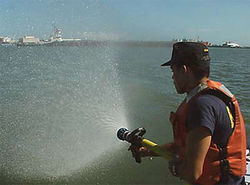 Worker sprays dispersant from hose Worker sprays dispersant from hose
|
People preparing spill response plans for many U. S. coastal regions now include dispersant use as a response option under certain conditions. In other parts of the world, such as in Great Britain and Europe, dispersants have become the main response technique for oil spills. Dispersant use was considered to be a major factor in reducing shoreline oiling and biological impacts at the Sea Empress oil spill in Wales in 1996.
The photo at left was taken during a November 1999 incident in Puerto Rico, in which a grounded freighter was in danger of spilling fuel oil. Dispersants and a shipboard application system were deployed and tested, as shown at left, in case oil spilled during offloading of the ship's fuel. (Because no oil spilled, dispersants were not used at this incident).
How is NOAA Involved?
Our main role is to provide scientific support to the people who must plan for dispersant use in coastal regions around the US. As part of this work, we stay abreast of current research on dispersants, provide training about issues related to use of dispersants, and participate in developing dispersant monitoring programs (such as the SMART program). The photo below shows a NOAA (National Oceanic and Atmospheric Administration (NOAA), United States) spill response specialist training U.S. Coast Guard officers in the use of fluorometers for dispersant monitoring.
 NOAA specialist showing fluorometer reading to U.S. Coast Guard officers NOAA specialist showing fluorometer reading to U.S. Coast Guard officers
|
What's the Bottom Line?
 Four photos showing dispersant application, skimming, booming, and burning Four photos showing dispersant application, skimming, booming, and burning
|
Dispersants provide an effective tool for oil spill response on open water when conditions are appropriate. Some of the contents of the "spill response toolbox" include, in clockwise order from the upper left, dispersants, skimmers, booms, and burning (Health and safety aspects of in-situ burning of oil). Dispersants are usually used in conjunction with these other cleanup techniques.
